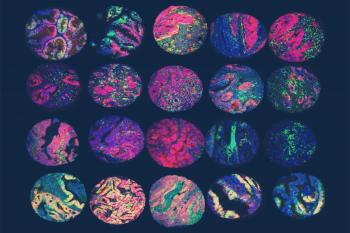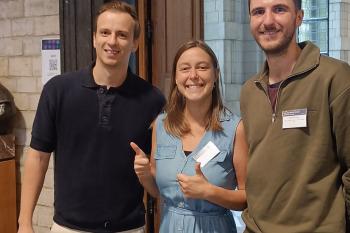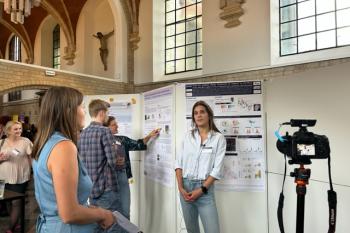The second edition of the Tumor Heterogeneity, Plasticity, and Therapy conference, held on October 3rd and 4th in the charming city of Leuven, Belgium, proved to be a resounding success.
With 350 participants hailing from 23 different countries, this two-day event provided an enriching platform for scientists, researchers, and clinicians to delve into the complex world of cancer, its heterogeneity, plasticity, and evolving therapeutic approaches. The conference was brimming with scientific talks, networking opportunities, and an impressive array of over 150 poster presentations.
A Diverse Gathering of Minds
One of the most striking aspects of the conference was the diversity of attendees, both in terms of geographical origin and professional backgrounds. Researchers, clinicians, and experts from North and South America, Europe, Asia, and beyond came together to share their insights and discoveries, fostering a truly global exchange of ideas.
The heart of any scientific conference lies in its presentations, and the Tumor Heterogeneity, Plasticity, and Therapy conference did not disappoint. Over the course of two days, a wide array of topics were explored, spanning from the molecular intricacies of tumor heterogeneity to innovative therapies aimed at combating cancer’s adaptability.
Several keynote speakers graced the event with their expertise. Their presentations, often visionary in nature, offered glimpses into the future of cancer research and treatment. These speakers not only shared their groundbreaking work but also challenged the audience to think differently about the possibilities for understanding and tackling cancer’s complexity.
Networking Opportunities That Sparked Collaborations
The importance of networking in the scientific community cannot be overstated. This conference provided ample opportunities for attendees to connect, exchange ideas, and form collaborations that could potentially lead to groundbreaking research. Coffee breaks, lunches, the reception, and the conference dinner allowed participants to engage in meaningful discussions with fellow researchers, fostering an atmosphere of collaboration and innovation.
Poster Sessions: A Visual Feast of Research
One of the highlights of the conference was the poster sessions, featuring over 150 posters from researchers across the globe. These posters were an essential part of the event, offering a visual representation of the breadth and depth of ongoing research in the field. Attendees had the opportunity to engage directly with poster presenters, facilitating in-depth discussions and the sharing of insights.
Lucile Bansard of CNRS was awarded the Nature Poster Prize with her presentation on the development of PROteolysis TArgeting Chimeras or PROTACs.

Speaker impressions of the conference
We asked keynote speaker Dana Pe'er why she thinks attending conferences is key to your scientific career:
I really think that the conferences are all about interactions. Both, me responding to the talk and the hallway conversations which really trigger my next ideas. I am bubbling with ideas.
Watch the video for the entire interview with Dana Pe'er.
Live tweeting during the conference
Three VIB Conference reporters covered the conference live on social media. They were Laurien Van Dyck, Marek Piprek and Panagiotis Karras, and all have a background in cancer research. Read their their observations below.
Laurien Van Dyck:
The speaker line-up was impressive, balancing speakers of different genders, ages, backgrounds and scientific fields. Daniela Thommen immediately set the scene for more discussions about intra- and inter-tumor heterogeneity, also in the immune compartment. While all speakers brought novel finding to the table, Humsa Venkatesh’s talk about the neural regulation of cancer was really mind-blowing (pun intended). Dana Pe’er really lived up to the expectations, presenting excellent science in a very captivating way. While, as many attendees, I was particularly looking forward to Dana’s talk, I also enjoyed being surprised by the fantastic scientific discoveries of other, sometimes unknown, speakers in the selected talks. No wonder the conference was sold-out!
In the (coffee) breaks, the conference room was buzzing with enthusiastic discussions and inspiring posters presentations. It was really a pleasure to walk around in a room filled with familiar faces and other THPT enthusiasts, enjoying good food while catching up. One advice: subscribe quickly, because the next edition might be sold-out even faster!
Marek Piprek:
The speaker that caught my attention was Itay Yanai. With his line of research inspired by different fields, which is unusual in cancer biology, he was able to understand the mechanism of resistance to anti-cancer treatment in a clean and simplistic way. His talk was engaging and motivating. Besides making notes during the lecture I have written down multiple ideas for future experiments, which I hope will help me to solve my scientific questions.
The other speaker was Dana Pe’er, the trained mathematician who has a goal to understand the biology of the tumor. Her methods are extremely well executed and helpful in times when the data analysis of results from everyday experiments is impossible without computational help. Her attention to drawing accurate biologically relevant conclusions is a great example for young researchers.The field of cancer biology is evolving and spreading across multiple, previously non-overlapping fields. To understand cancer development and its vulnerabilities we need to understand better the tumor microenvironment and its effect on cellular plasticity and the mechanisms that cancer uses to become malignant and resistant to standard of care treatment.
I noticed that all of the attendees were happy to talk about their great science. Cancer biology is a field of passionate people with a great goal to improve the quality of life of oncological patients. After this conference, I am certain that beating cancer is visible on the horizon. This is my motivation, as a person with a medical background who has seen how harmful this disease is.
Panagiotis Karras:
During the conference, we had the privilege of hearing from a lineup of top leader speakers. Sean Morrison for instance delivered an impressive presentation on hematopoietic stem cell niches, shedding light on their crucial role in the bone marrow and their intricate interactions with endothelial cells. Nuria Lopez Bigas captivated the audience with fascinating data on the evolution of somatic mutations in healthy tissues and in cancer. Dana Pe’er's talk was nothing short of phenomenal, as she explored the causes and consequences of plasticity in premalignant states and during pancreatic cancer progression. She also introduced novel pipelines for predicting cell-cell interactions and provided insights into new spatial analysis methods. Itai Yanai presented exciting findings on how cells adapt to drug exposure, acquiring diverse phenotypes to overcome resistance. Humsa Venkatesh unraveled novel insights into the role of the nervous system in regulating the progression of gliomas and potential targeted approaches. Lastly, Richard White discussed the spatial location of melanoma cells at the invasive front and their interactions with adipocytes, revealing how these factors fuel metastasis in zebrafish models.
During these two days of meetings, the scientific community thoroughly dissected the recent findings on cancer plasticity, a field that has advanced significantly. These discussions provided fresh insights into what lies ahead and identified the major challenges that we must address in the upcoming years. To effectively combat cancer, it is essential that we gain a precise understanding of the mechanisms underlying plasticity and develop strategies to target the plasticity of cells.
The interactions between group leaders and graduate students as well as postdocs were highly dynamic and engaging. All the attendees were keen to initiate discussions and start collaborations. The poster sessions proved to be a success, drawing the interest of numerous attendees. These sessions generated valuable ideas and insights, providing presenters with ideas on how to advance their projects. Finally, I noticed that many attendees already started to ask when the 3rd edition of this meeting is scheduled.


Why is tumor heterogeneity such a hot topic?
We asked organizing committee member Chris Marine why this topic is so topical and important.
It's only in the last few years that some technologies have allowed us to actually now delve into this problem. We can now map heterogeneity and understand where it comes from. And advance our understanding of cancer biology that way.
He also talks about the importance of attending conferences in the scientific process. Watch the video for the entire interview.
Conclusion
The second edition of the Tumor Heterogeneity, Plasticity, and Therapy conference in Leuven was a dynamic and illuminating event that brought together scientists and researchers from around the world. It provided a fertile ground for sharing knowledge, fostering collaborations, and igniting discussions that will undoubtedly continue to shape the future of cancer research and treatment.
As we look forward to future editions of this conference, we can anticipate even greater strides in our understanding of tumor heterogeneity, plasticity, and the development of more effective therapeutic strategies against cancer.
You can watch a photo album of the conference here.
Take a look at the THPT23 conference website here.